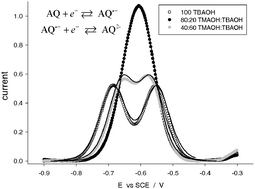Square wave voltammetry at disc microelectrodes for characterization of two electron redox processes
Abstract
Analytical explicit solutions are presented for the use of

* Corresponding authors
a
Departamento de Química Física, Universidad de Murcia, 30100 Murcia, Spain
E-mail:
amolina@um.es
Fax: +34 868 88 4148
Tel: +34 868 88 7524
b
Department of Chemistry, Physical and Theoretical Chemistry Laboratory, Oxford University, South Parks Road, Oxford OX1 3QZ, UK
E-mail:
richard.compton@chem.ox.ac.uk
Fax: +44 (0)1865 275 410
Tel: +44 (0)1865 275 413
Analytical explicit solutions are presented for the use of

 Please wait while we load your content...
Something went wrong. Try again?
Please wait while we load your content...
Something went wrong. Try again?
E. Laborda, A. Molina, Q. Li, C. Batchelor-McAuley and R. G. Compton, Phys. Chem. Chem. Phys., 2012, 14, 8319 DOI: 10.1039/C2CP40265C
To request permission to reproduce material from this article, please go to the Copyright Clearance Center request page.
If you are an author contributing to an RSC publication, you do not need to request permission provided correct acknowledgement is given.
If you are the author of this article, you do not need to request permission to reproduce figures and diagrams provided correct acknowledgement is given. If you want to reproduce the whole article in a third-party publication (excluding your thesis/dissertation for which permission is not required) please go to the Copyright Clearance Center request page.
Read more about how to correctly acknowledge RSC content.
 Fetching data from CrossRef.
Fetching data from CrossRef.
This may take some time to load.
Loading related content
